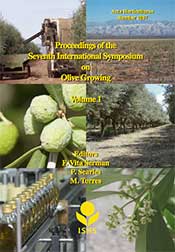Ver ítem
- xmlui.general.dspace_homeCentros Regionales y EEAsCentro Regional Mendoza - San JuanEEA San JuanArtículos científicosxmlui.ArtifactBrowser.ItemViewer.trail
- Inicio
- Centros Regionales y EEAs
- Centro Regional Mendoza - San Juan
- EEA San Juan
- Artículos científicos
- Ver ítem
Co-composting alperujo with other agro-industrial residues as sustainable practice for its recycling
Resumen
The main by-product generated by Argentinean olive oil industry is a semisolid cake made of olive pulp, stone and vegetation water locally called alperujo. It is reported that composting represents an interesting option to recycle it; however, this practice is rarely implemented by olive industries in Argentina. The aim of this work was to evaluate two low-technology methods, open and covered piles with mechanical turnovers, for their effect on composting
[ver mas...]
The main by-product generated by Argentinean olive oil industry is a semisolid cake made of olive pulp, stone and vegetation water locally called alperujo. It is reported that composting represents an interesting option to recycle it; however, this practice is rarely implemented by olive industries in Argentina. The aim of this work was to evaluate two low-technology methods, open and covered piles with mechanical turnovers, for their effect on composting a mixture of alperujo, olive leaves and grape stalk (56:22:22) with or without urea addition. Temperature, organic matter content (OM) and phenolic compounds (PC) were measured to follow up the composting process. While electrical conductivity (EC), pH, macroand micro-nutrients, as well as germination index (GI) of Medicago sativa seeds were determined at the end of the experiment in order to assess compost quality. Additionally, to infer the soil and water conditions required to apply the obtained compost, the agricultural index (AgIndex) was calculated. Results showed that all piles presented similar evolution patterns, achieving maturity within 150 days. Temperature rose upwards in the thermophilic phase and next it decreased through the maturation phase. pH increased along the experiment and reached slightly alkaline level at maturity. OM content and C/N ratio decreased, this decrease being higher in covered piles than in open ones. Interestingly, PC was highly reduced in all treatments and was inversely correlated with the increase in GI. Furthermore AgIndex indicated that the obtained compost may be appropriate for amending soils with excellent drainage characteristics, low salt content and good water quality. The results suggest that evaluated methods are suitable for composting alperujo, decrease its toxicity and obtain a product appropriate for amending soils where olive groves are usually implanted. Undoubtedly the long time required to reach maturity may represent a negative feature. In this sense further works, focused on conditions to accelerate the process should be carried out.
[Cerrar]

Autor
Monetta, Pablo Miguel;
Sanchez-Montilla, R.;
Bosch-Rubia, G.;
Rizzo, Pedro Federico;
Crespo, Diana Elvira;
Gouiric, S.;
Vallejo Herrera, M.;
Descripción
Trabajo presentado al VII International Symposium on Olive Growing, 2014
Fuente
Acta Horticulturae 1057 : 709-716 (Oct. 2014)
Fecha
2014-10-30
Editorial
ISHS
ISSN
0567-7572
2406-6168
2406-6168
ISBN
978-94-62610-47-7
Formato
pdf
Tipo de documento
artículo
Palabras Claves
Derechos de acceso
Restringido
 Excepto donde se diga explicitamente, este item se publica bajo la siguiente descripción: Creative Commons Attribution-NonCommercial-ShareAlike 2.5 Unported (CC BY-NC-SA 2.5)
Excepto donde se diga explicitamente, este item se publica bajo la siguiente descripción: Creative Commons Attribution-NonCommercial-ShareAlike 2.5 Unported (CC BY-NC-SA 2.5)

